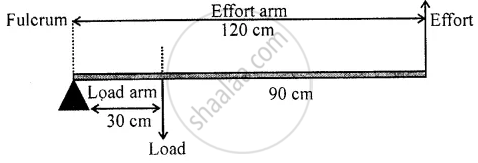Advertisements
Advertisements
Question
In a lever, the fulcrum is at one end at a distance of 30 cm from the load and effort is at the other end at a distance of 90 cm from the load. Find :
(a) the length of load arm,
(b) the length of effort arm, and
(c) the mechanical advantage of the lever.
Solution

Given,
(a) Load arm = 30 cm
(b) Effort arm = (90 + 30) cm = 120 cm
(c) Mechanical advantage = `"Effort arm"/"Load arm"`
= `"120 cm"/"30 cm"`
= 4
APPEARS IN
RELATED QUESTIONS
Name the class to which the following lever belong:
a beam balance
Name the class to which the following lever belong:
a wheelbarrow
Name the class to which the following lever belong:
a see-saw
Tick the most appropriate answer.
A pair of scissors is an example of a/an
Answer the following in short.
What is the basis of the classification of levers?
Explain why scissors for cutting cloth may have blades longer than the handles, but shears for cutting metals have short blades and long handles.
Which type of lever has a mechanical advantage always more than one? Give one example. What change can be made in this lever to increase its mechanical advantage?
Draw a labelled diagram of a class II lever. Give one example of such a lever.
Match the following:
| 1. | Class I lever | a. | Wheelbarrow |
| 2. | Class II lever | b. | Seesaw |
| 3. | Class III lever | c. | Axe |
| 4. | Wedge | d. | Hockey sick |
Classify the following into levers:
Claw hammer
